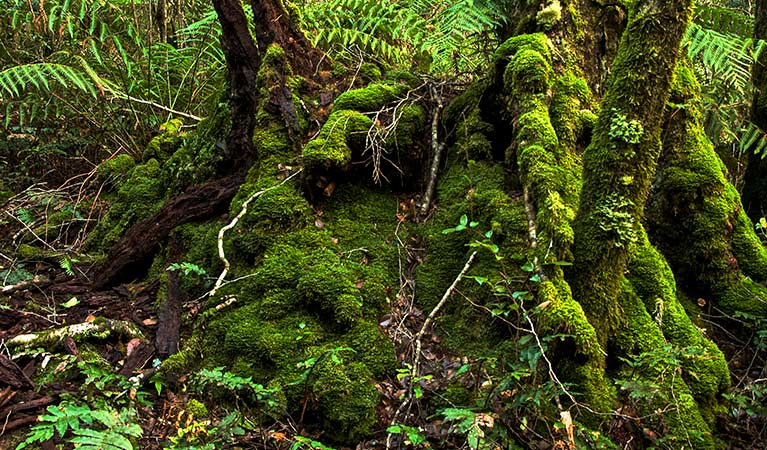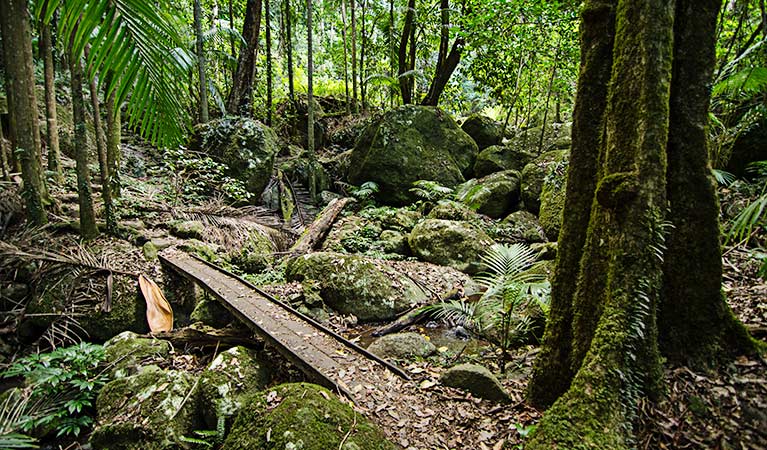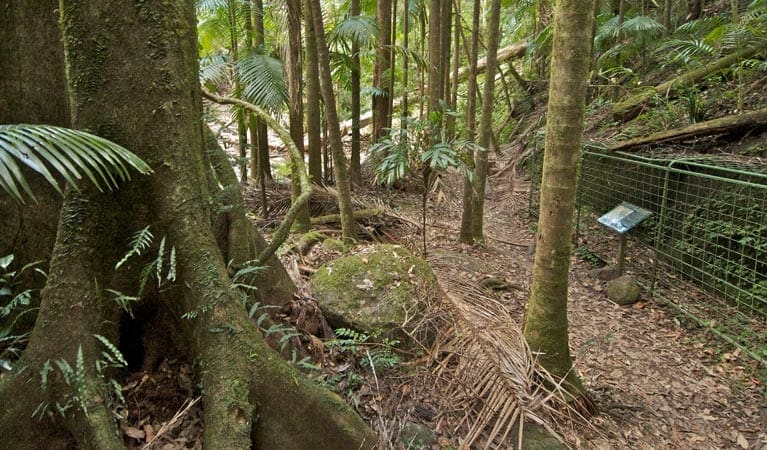Trail Fast Facts
Helmholtzia loop walking track is a 1km, grade 3 hike in Border Ranges National Park, New South Wales. This hike typically takes 45 minutes to complete.
Hike Overview
Helmholtzia loop walking track takes you on a short, easy walk through a beautiful section of Border Ranges National Park. It takes you across pristine Brindle Creek on low bridges and into World Heritage rainforest.
The name of this track comes from the helmholtzia plant that grows in the area. Also referred to as the stream lily, this rare plant is found only in the rainforest of north-east NSW and south-east Queensland. Helmholtzia are large strap-leafed plants which require a reliable water supply and are usually found along the banks of creeks and in gullies.
Helmholtzia loop walking track is also home to hoop pines, stands of Antarctic beech and abundant epiphytes - a plant that grows on another without being a parasite, while sourcing moisture and nutrients from the atmosphere and nearby debris.
Be sure to bring your binoculars along for a spot of birdwatching and keep your eyes and ears out for some endangered frog species including Fleay's barred frog and pouched frog.
Take a virtual tour of Helmholtzia loop walking track captured with Google Street View Trekker.
Track Grade
Grade 3 (Moderate) - Walks for Most Fitness Levels: Grade 3 on the AWTGS represents moderate walking tracks. These are ideal for walkers with some fitness who are comfortable with some hills and uneven terrain. While suitable for most ages, some bushwalking experience is recommended to ensure a safe and enjoyable experience. Tracks may have short, steep hill sections, a rough surface, and many steps. The total distance of a Grade 3 walk can be up to 20 kilometers.
Tips
It's a good idea to fill your fuel tank before heading out to the park as the closest service stations are Kyogle, Woodenbong, Nimbin and Rathdowney.
The weather in the area can be extreme and unpredictable, so please ensure you're well-prepared for your visit.
Remember to take your binoculars if you want to go birdwatching
Visit NSW National Parks and Wildlife Service for more information on this trail.
The longitude and latitude of the start and end points are approximately only and should not be used for navigation purposes. Please contact me if you know the correct coordinates.
Map and GPX file
Looks like I don’t have a GPX file for this trail yet. If you have one you’d be willing to share, please email it to me so we can help other hikers have a safer, easier time out there. I’ll double-check each file to make sure it aligns with official tracks and topo maps before adding it to this hike. Thanks so much for helping build an even better hiking resource.
Trailhead
Sorry, no records were found. Please adjust your search criteria and try again.
Sorry, unable to load the Maps API.
Getting there
Helmholtzia loop walking track is in the eastern precinct of Border Ranges National Park. To get there:From Murwillumbah:Travel south-west on Kyogle Road to Lillian Rock, then turn right onto Williams Road.Travel along Williams Road for 2.5km, then Creegans Road for 6km, until you reach the park boundary.From the boundary, continue 26km along Tweed Range Scenic Drive to Brindle Creek Road intersection, then turn right.Travel 2km to Brindle Creek carparkFrom Kyogle:Travel north along Summerland Way for 14km until you reach WiangareeTurn right at Wiangaree into Lynches Creek Road and travel east for 12km to Forest RoadTurn right onto Forest Road and continue 4.5km to the park boundaryFrom the boundary, continue on Tweed Range Scenic Drive for 6.5km and then turn left onto Bridle Creek Road.Travel 2km to Brindle Creek carpark Parking Parking is available at Brindle Creek carpark.
Photo gallery
If you’ve got some great shots from this hike, I’d love to see them! Please upload your .jpg files here to help inspire other hikers and show off the beauty of the trail.
A quick note: Uploading your photos doesn’t mean you lose ownership. You’ll be credited for any photos you share, and you can request to have them removed at any time.
About the region
Border Ranges National Park in the North Coast region
Border Ranges National Park is always open but may have to close at times due to poor weather or fire danger.
Suggest an edit
Spotted a change on this trail? Maybe there are new features, the route has shifted, or the trail is permanently closed. Whatever the update, I’d love your input. Your feedback helps fellow hikers stay informed and ensures that our trail info stays fresh and reliable.
Similar trails nearby
Looking for things to do in Border Ranges National Park or nearby? Try these similar hikes or bushwalks.
Let someone know
Adventure with Confidence: Register Your Trip Plans
Before you hit the trail, take a moment to fill out our trip intentions form. It’s a simple way to share important details about your hike with family or friends. If things don’t go as planned and you’re not back on time, they can easily notify emergency services, helping to ensure a quick response and reducing worry. Enjoy your outdoor adventure knowing that you’ve taken a smart step for your safety.
Gear to consider
What you carry in your pack will depend on the weather, terrain, time of year, type of adventure, and personal preferences. Having trouble deciding what gear’s right for you? My free planning, food and packing checklists provide an introduction to things your could consider (as well as the Ten Essentials) on your day, overnight and multi-day adventures. Customise your kit according to your personal needs, always considering safety first.
Explore Safe
While planning your hike, it’s important to check official government sources for updated information, temporary closures and trail access requirements. Before hitting the trail, check local weather and bushfire advice for planned burns and bushfire warnings and let someone know before you go. Plan ahead and hike safely.
Weather
Acknowledgement of Country
Trail Hiking Australia acknowledges the Traditional Owners of the lands on which we hike and pay respects to their Elders, past and present, and we acknowledge the First Nations people of other communities who may be here today.






